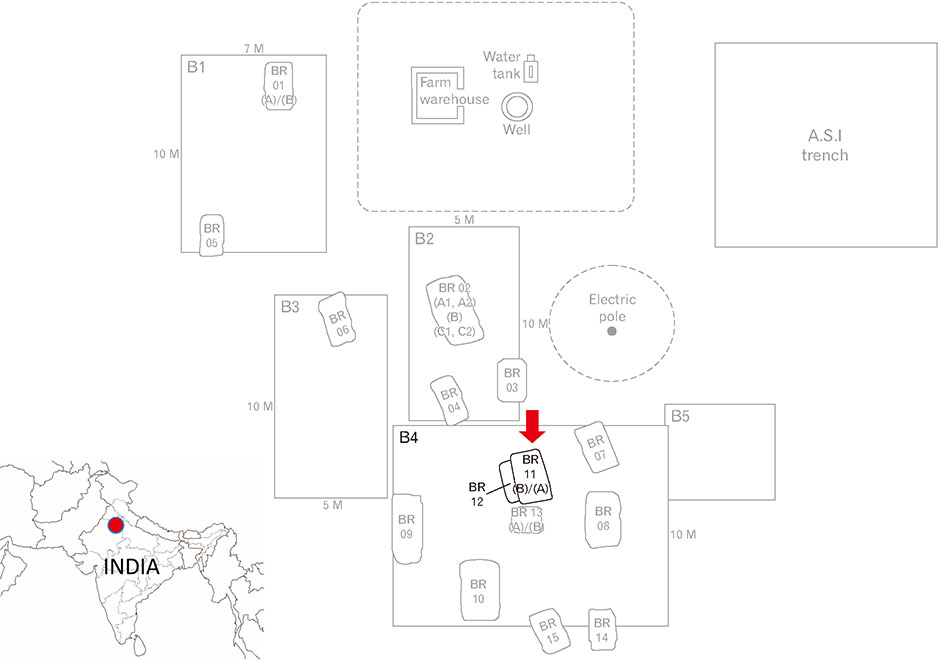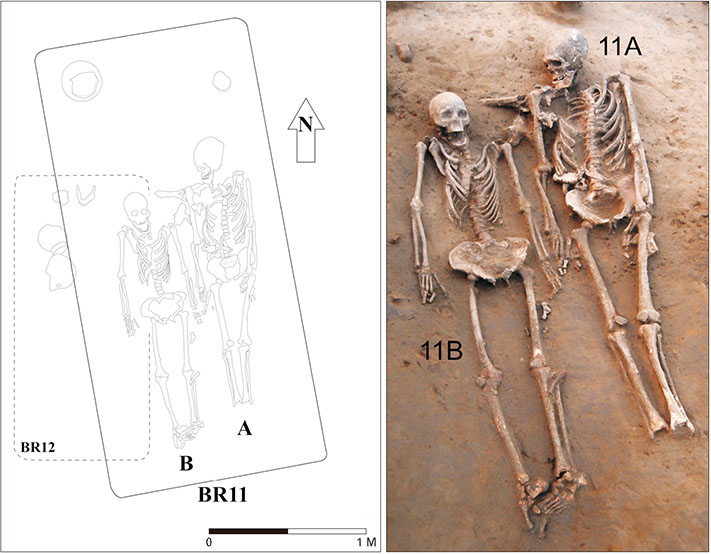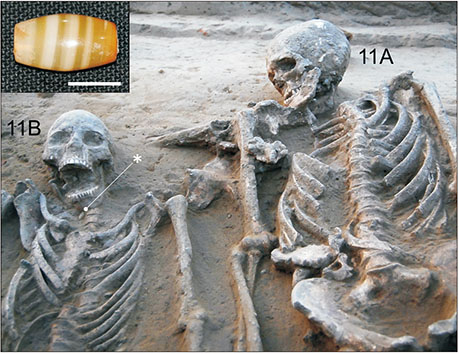Anat Cell Biol.
2018 Sep;51(3):200-204. 10.5115/acb.2018.51.3.200.
A young couple's grave found in the Rakhigarhi cemetery of the Harappan Civilization
- Affiliations
-
- 1Department of Archaeology, Deccan College, Pune, India. vasant.shinde@dcpune.ac.in
- 2Institute of Forensic Science, Seoul National University College of Medicine, Seoul, Korea. cuteminjae@gmail.com
- KMID: 2447013
- DOI: http://doi.org/10.5115/acb.2018.51.3.200
Abstract
- The Harappan Civilization, one of the earliest complex societies in the world, flourished on the Indian subcontinent. Although many additional Harappan settlements and cemeteries have been discovered and investigated, no coupled burials at Harappan cemeteries have been reported to date. In 2013-2016, we excavated the cemetery of the Rakhigarhi site (Haryana), the largest city of the Harappan Civilization. At the site, we found a grave that turned out to be a coupled (joint) burial of the primary type. This report is the first anthropologically confirmed case of coupled burial from a Harappan cemetery.
MeSH Terms
Figure
Reference
-
1. Shinde VS. Current perspectives on the Harappan Civilization. In : Schug GR, Walimbe SR, editors. A Companion to South Asia in the Past. Chichester: John Willey & Sons, Inc;2016. p. 127–144.2. Shinde VS, Kim YJ, Woo EJ, Jadhav N, Waghmare P, Yadav Y, Munshi A, Chatterjee M, Panyam A, Hong JH, Oh CS, Shin DH. Archaeological and anthropological studies on the Harappan cemetery of Rakhigarhi, India. PLoS One. 2018; 13:e0192299.
Article3. Singh U. A history of ancient and early medieval India: from the stone age to the 12th century. London: Pearson;2009. p. 173.4. Buikstra J, Ubelaker D. Standards for data collection from human skeletal remains. Arkansas archaeological survey research series No. 44. Fayetteville, AR: Arkansas Archeological Survey;1994.5. Brothwell DR. Digging up bones: the excavation, treatment and study of human skeletal remains 3rd ed. Ithaca, NY: Cornell University Press;1981.6. Lovejoy CO, Meindl RS, Pryzbeck TR, Mensforth RP. Chronological metamorphosis of the auricular surface of the ilium: a new method for the determination of adult skeletal age at death. Am J Phys Anthropol. 1985; 68:15–28.
Article7. Brooks S, Suchey JM. Skeletal age determination based on the os pubis: a comparison of the Acsádi-Nemeskéri and Suchey-Brooks methods. Hum Evol. 1990; 5:227–238.
Article8. Lukacs JR, Pastor RF. Activity-induced patterns of dental abrasion in prehistoric Pakistan: evidence from Mehrgarh and Harappa. Am J Phys Anthropol. 1988; 76:377–398.
Article9. Trotter M, Gleser GC. A re-evaluation of estimation of stature based on measurements of stature taken during life and of long bones after death. Am J Phys Anthropol. 1958; 16:79–123.
Article10. Ortner DJ. Identification of pathological conditions in human skeletal remains. San Diego, CA: Academic Press;2003.11. Robbins Schug G. A hierarchy of values: the bioarchaeology of complexity, order, health, and hierarchy at Harappa. In : Klaus H, Harvey AR, Cohen MN, editors. Bones of Complexity: Osteological Indicators of Emergent Heterarchy and Hierarchy. Gainesville, MD: University Press of Florida;2017. p. 263–289.12. Rao SR. Lothal: a Harappan port town (1955–62) (Vol. 1). Memoirs of the archaeological survey of India (No. 78). New Delhi: Archaeological Survey of India;1979.13. Sarkar SS, Chapter XV. Human skeletal remains from Lothal. In : Rao SR, editor. Lothal: a Harappan Port Town. Vol II. New Delhi: Archaeological Survey of India;1985. p. 296–304.14. Urbanus J. Eternal embrace. Archaeol Mag. 2008; 61:36–38.15. Liesowska A. Modern science to unlock the secrets of couples holding each other in loving embrace for 3,500 years [Internet]. The Siberian Times;2013. cited 2013 Dec 27. Available from: http://siberiantimes.com/science/casestudy/features/modern-science-to-unlock-the-secrets-of-couples-holding-each-other-in-loving-embrace-for-3500-years/.16. Romeo N. Embracing stone age couple found in Greek cave [Internet]. National Geographic;2015. 2015 Feb 20. Available from: https://news.nationalgeographic.com/2015/02/150220-embracing-skeletons-greece-diros-alepotrypa-cave-archaeology/.17. Lukacs JR, Walimbre SR. Excavations at Inamgaon: Vol. II. The physical anthropology of human skeletal remains. Osteobiogeographic analysis. Pune: Deccan College Postgraduate and Research Institute;1986.18. Varma RK. Couple and multiple couple burials of the mesolithic in the Ganga valley. In : Joshi JP, Sinha DK, Lal BB, editors. Facets of Indian Civilization: Recent Perspectives: Essays in Honor of Prof. BB Lal, Vol. I. New Delhi: Aryan Books International;1999. p. 29–34.
- Full Text Links
- Actions
-
Cited
- CITED
-
- Close
- Share
- Similar articles
-
- Human Skeletal Remains from Ancient Burial Sites in India: With Special Reference to Harappan Civilization
- A Case Study of the Fetal Skeleton from a Joseon Period Cemetery
- “Insanity Is the Price of Modern Civilization”: The Discourse of Civilization and the Asian Insane in Modern America
- Anthropological report of arctic people’s mummy found at a medieval grave of West Siberia
- The Psychoanalytical Work with the Couples





